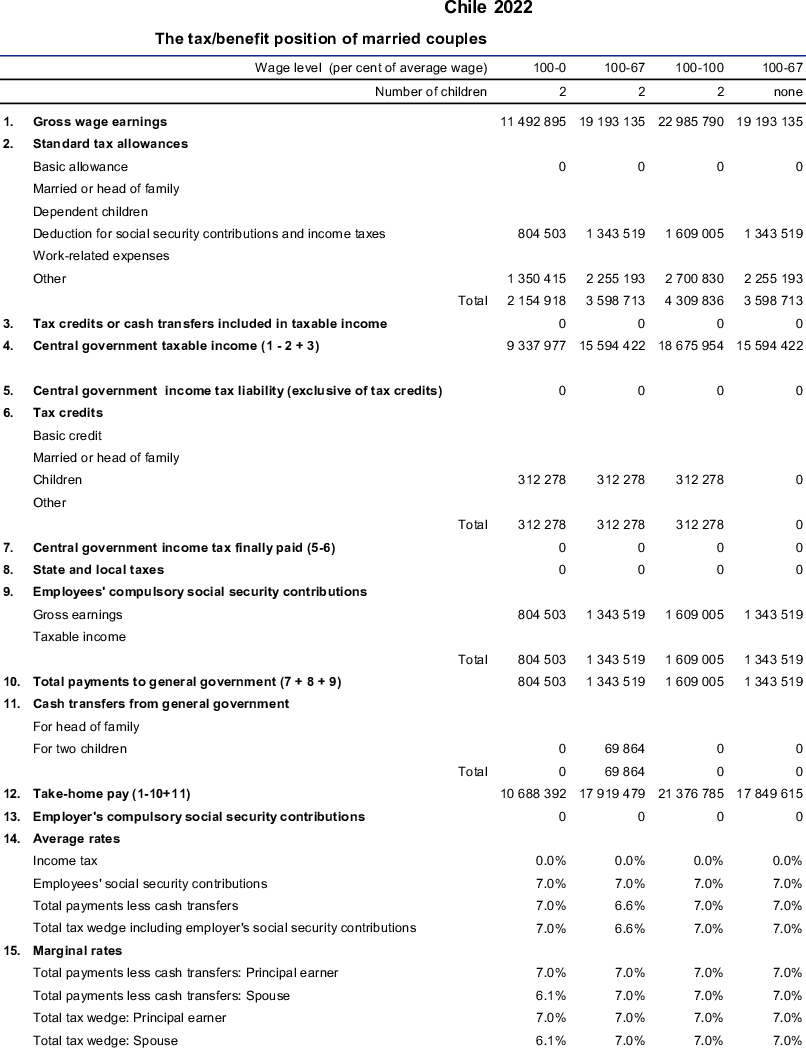Employees have mandatorily to contribute 7% of their income to a health insurance plan subject to an upper earnings limit of CLP 32 579 570 (UF 979.2). They are free to choose whether to pay into a government-managed plan or alternatively to a private insurer3 (Isapres). The public insurance is based on a joint system that, in general, operates on an equal basis for all its beneficiaries, irrespective of the risk and the amount of the individual contribution. Its financing is partly covered by the contributions and partly by way of a government subsidy. Premiums paid to the plans offered by Isapres are based on the contributors’ individual risk and these plans are exclusively financed with the employees’ contributions. Public insurance contributions are included in the modelling as the majority of employees pay into plans managed by the government sector.
Employee social security contributions in respect of pensions and unemployment are not classified as taxes in this report; though they are included in modelling as deductions for income tax.
The mandatory contributions to pension funds and unemployment insurance plans are not classified as taxes, since the payments are made to private institutions. In 1980, the public social security system was replaced with a privately managed individual capitalisation system. This system is obligatory to all employees who have joined the labour force since 1983 and free-lance workers since 2012, and of a voluntary nature to all contributing to the former system. The contributions to the old government operated pension fund system are not included in the modelling because they relate to a minority of employees and the system will eventually disappear once the contributions and related benefit payments to those individuals remaining in it have ceased.
The modelling allows that the contributions to pension funds and unemployment insurance managed by private institutions are deducted from gross income. In the case of their pension funds, these payments amount to 10% of their gross income, with an upper earnings limit of 32 579 570 (UF 979.2). Added to that there is an amount that varies depending on the managing company that covers the management of each pension fund account.4 The monthly unemployment insurance premium is 0.6% of the employee’s gross income, with an upper earnings limit of CLP 48 949 207 (UF 1 471.2). Employees do not pay the monthly unemployment insurance premium when they have a fixed-term contract or after 11 years of labour relationship.
There are also mandatory contributions to managed funds by members of the police force and the army which are classified as taxes but are not included in the modelling as they relate to a minority of the overall workforce.
If the employee has a high risk job, that person has to make an additional contribution of 2% (heavy work) or 1% (less heavy work) of the gross income with an upper earnings limit of CLP 32 579 570 (UF 979.2) to the pension fund account.
The pension and unemployment contributions are not included in the Taxing Wages calculations, as they are not considered as taxes in the report. However, information on “non-tax compulsory payments” as well as “compulsory payment indicators” is included in the OECD Tax Database, which is accessible at www.oecd.org/ctp/tax-database.htm.


